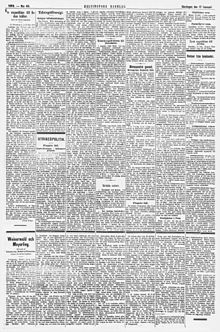Feuilleton
A feuilleton (French pronunciation: [fœjtɔ̃]; a diminutive of French: feuillet, the leaf of a book) was originally a kind of supplement attached to the political portion of French newspapers, consisting chiefly of non-political news and gossip, literature and art criticism, a chronicle of the latest fashions, and epigrams, charades and other literary trifles.[1] The term feuilleton was invented by the editors of the French Journal des débats; Julien Louis Geoffroy and Bertin the Elder, in 1800. The feuilleton has been described as a "talk of the town",[2] and a contemporary English-language example of the form is the "Talk of the Town" section of The New Yorker.[3] In English newspapers, the term instead came to refer to an installment of a serial story printed in one part of a newspaper.[1]
History[]

The feuilleton was the literary consequence of the Coup of 18 Brumaire (Dix-huit-Brumaire). A consular edict of January 17, 1800, made a clean sweep of the revolutionary press, and cut down the number of Paris newspapers to thirteen. Under the Consulate, and later on the Empire, Le Moniteur Universel, which served as a propaganda mouthpiece for Napoleon Bonaparte, basically controlled what the other twelve Parisian publications could write. Julien Louis Geoffroy found that what might not be written in an editorial column might appear with perfect impunity on a lower level on the rez-de-cbausee, the "ground floor" of a journal.[4] Geoffroy started the first feuilleton in the Journal des Debats,. The idea caught on at once. The feuilleton, which dealt ostensibly with literature, the drama and other harmless topics, but which, nevertheless, could make political capital out of the failure of a book or a play, became quite powerful under the Napoleonic nose.[4] The original feuilletons were not usually printed on a separate sheet, but merely separated from the political part of the newspaper by a line, and printed in smaller type.[1]
Geoffroy's own feuilleton dealt with the theatre. He was a trenchant critic. He died in 1814, and other feuilletonists followed. After him came Janin. On other papers there were feuilletonists like Théophile Gautier, Paul de St. Victor, Edmond de Biéville, Louis Ulbach, Francisque Sarcey, who occupied the "ground floor" of the Temps . The musical feuilleton has been signed by Adolphe Adam, Hector Berlioz, and Coutil-Blaze. The scientific variety by Babinet, Louis Figuier and Meunier. The bibliographical by Armand de Pontmartin, Gastave Flanche, and Charles Augustin Sainte-Beuve.[4]
Since Geoffrey's time, the feuilleton cannot be said to have fairly "boomed" until novelists appeared there. The Count of Monte Cristo the Mousquetaires and Vingt Ans Apres all filled the "ground floors" of the Siecle. Eugène Sue's Mysteres de Paris, was seen in the Debate, and his Juif Errant, in the Constitutionnel.[4]
References in literary works[]
In the novel The Glass Bead Game (1943) by Nobel Prize-winning novelist Hermann Hesse, the current era is characterised and described as "The Age of the Feuilleton".[5]
See also[]
- Causerie
- Op-ed
- Column (newspaper)
- Serial novel
- Sunday Supplement
- The Third Culture (1995), book that inspired several German newspapers to integrate scientific reports into their "Feuilleton" sections
- Feuilletine
References[]
- ^ Jump up to: a b c Chisholm, Hugh, ed. (1911). . Encyclopædia Britannica. 10 (11th ed.). Cambridge University Press. p. 305.
- ^ Conway, Daniel W.; Gover, K. E., Søren Kierkegaard, p. 248
- ^ Walter Benjamin meets Monsieur Hulot, James Buchan, The Guardian, 8 March 2003
- ^ Jump up to: a b c d "The Feuilleton: Its Effect Upon Journalism in France". The Buffalo Commercial. November 3, 1900. p. 7. Retrieved 2021-08-06.
- ^ Hesse, Hermann. Das Glasperlenspiel: Versuch einer Lebensbeschreibung des Magister Ludi Josef Knecht samt Knechts hinterlassenen Schriftens. Frankfurt am Main: Suhrkamp, 2003. ISBN 3-518-41335-X. p. 16-17. "Die geistige Bewegung, deren Früchte unter vielen anderen die Einrichtung des Ordens und das Glasperlenspiel sind, hat ihre Anfänge in einer Geschichtsperiode, welcher seit der grundlegenden Untersuchungen des Literarhistorikers Plinius Ziegenhals den von ihm geprägten Namen 'Das Feuilletonistische Zeitalter' trägt."
Bibliography[]
- Dianina, Katia. "The Feuilleton: An Everyday Guide to Public Culture in the Age of the Great Reforms,", The Slavic and East European Journal, Vol. 47, No. 2 (Summer, 2003), pp. 187–210.
- Newspapers
- French words and phrases
